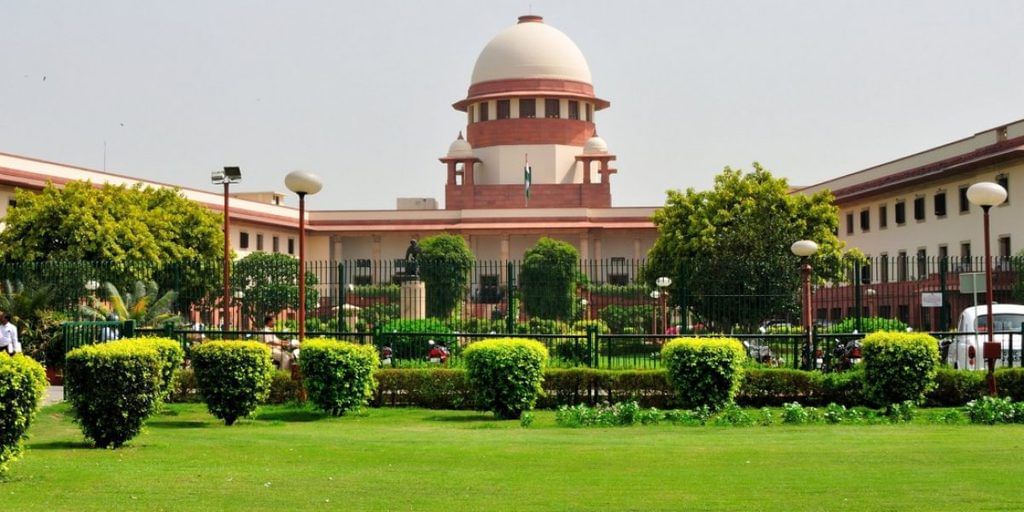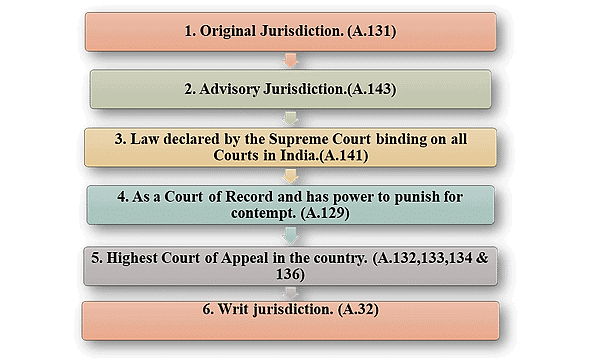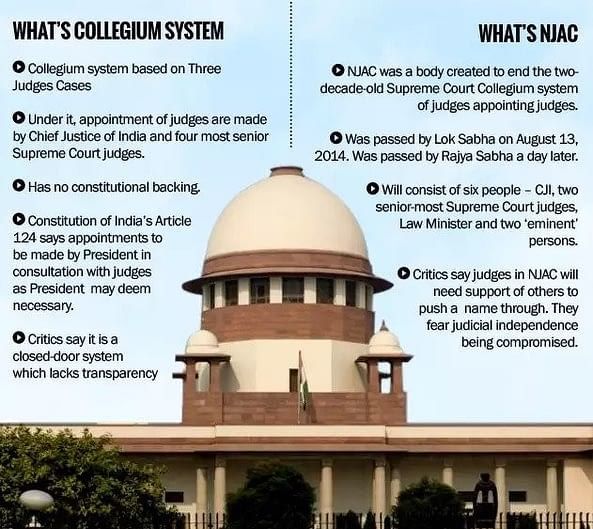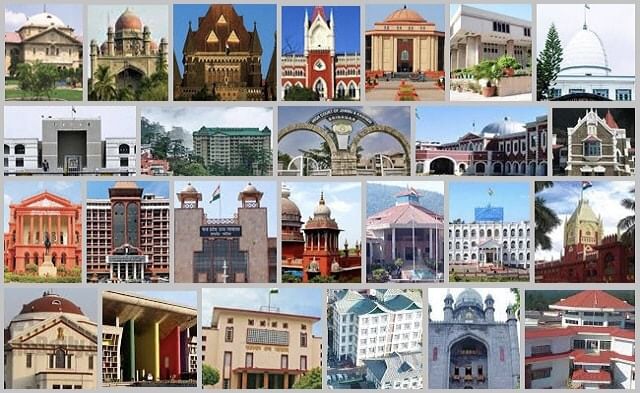The Judiciary | Legal Reasoning for CLAT PDF Download
| Table of contents |

|
| Introduction |

|
| Hierarchy of Courts |

|
| Supreme Court (Art 124-147) |

|
| Jurisdiction and Powers of Supreme Court |

|
| The High Courts |

|
| Key Developments |

|
| Conclusion |

|
Introduction
The judiciary in India plays a crucial role in upholding the Constitution and ensuring justice. It is an independent body, separate from the executive and legislative branches of government. The judiciary's primary function is to interpret and apply the law, resolve disputes, and protect the rights and liberties of citizens.Hierarchy of Courts
The Indian judicial system is organized in a hierarchical structure, ensuring systematic administration of justice across the nation. The courts are arranged as follows:
Supreme Court: The apex court, serving as the final court of appeal and the ultimate interpreter of the Constitution.
High Courts: Operate at the state or union territory level, overseeing judicial administration within their jurisdiction.
District Courts: Function at the district level, handling civil and criminal cases.
Subordinate Courts: Include Sessions Courts, Magistrate Courts, and specialized tribunals, operating under District Courts.
Supreme Court → High Courts → District Courts → Subordinate Courts
Supreme Court (Art 124-147)
- At the time of India's Independence, the judicial system was already in place with a Federal Court, which was later dissolved to make way for the Supreme Court.
- The first High Court in India, known as the Bombay High Court today, was established in 1865.
- The Supreme Court holds the position of the highest authority in the judicial system and is recognized as the third pillar of democracy.
- Article 124 of the Constitution governs the process of appointing and removing Supreme Court Judges.
- Article 217 governs the process for appointing High Court Judges.
- Although the Constitution designates Delhi as the seat of the Supreme Court, it allows the Chief Justice of India the flexibility to choose other locations as needed.
 The Supreme Court of India
The Supreme Court of India
Jurisdiction and Powers of Supreme Court
1. Original jurisdiction (Article 131)
It means that only Supreme Court can hear such cases and so has the original jurisdiction.
- Disputes between the central government and one or more states.
- Disputes between different states.
- Cases related to the enforcement of fundamental rights.
- Example: The Punjab Water Agreements Act, 2004 termination dispute was referred to the Supreme Court.
2. Appellate Jurisdiction (Article 132-134)
Hears appeals from High Courts in:
Constitutional Matters: Involving substantial questions of constitutional law (Article 132).
Civil Matters: Involving substantial questions of law of general importance (Article 133).
Criminal Matters: Where High Courts reverse acquittals or impose death sentences (Article 134).
Special Leave Petition (SLP) (Article 136): Discretionary power to grant leave to appeal in any matter for justice delivery.
3. Advisory Jurisdiction (Article 143)
The President may seek the Court’s opinion on questions of law or fact of public importance.
The Court must provide its opinion, but it is not binding on the President.
Example: In re: Special Reference No. 1 of 2002 on the Gujarat riots.
 Powers of Supreme Court
Powers of Supreme Court
4. Writ Jurisdiction (Article 32)
Allows individuals to approach the Supreme Court directly for enforcement of Fundamental Rights through writs (habeas corpus, mandamus, prohibition, certiorari, quo warranto).
Described by Dr. B.R. Ambedkar as the “heart and soul” of the Constitution.
5. Court of Record (Article 129)
- The Supreme Court is court of record and the same are admissible of evidentiary value and cannot be questioned in any court. It also enjoys the power to punish for its contempt.
6. Additional Powers:
Review of Judgments (Article 137): Can review its own judgments to correct errors.
Election Disputes (Article 71): Exclusive jurisdiction over disputes regarding the election of the President and Vice-President.
Constitutional Interpretation: Acts as the final interpreter of the Constitution (e.g., Kesavananda Bharati case, 1973).
Terms and Salary of CJI and Supreme Court Judges
- The Chief Justice of India and other Supreme Court judges hold office till 65 years of age.
- They can submit their resignation to the President
- After retirement, a Supreme Court Judge cannot plead or act before any authority in India.
- However, he can be appointed by the Government to any other position, as there is no bar on their appointment.
- The salary and the benefits of the judges are determined by the Parliament from time to time. The salaries, allowances, and pensions of the judges and the staff are charged on the consolidated fund of India and are non-votable by the Parliament.
Appointments of Judges of Supreme Court
- The judges of the Supreme Court are appointed by the President in consultation with the Chief Justice of the Supreme Court. This system of appointment is known as 'Collegium System' which consist of the Chief Justice and four senior most judges of Supreme Court appointing judges to Supreme Court and different High Courts.
- Recently Parliament passed a law, National Judicial Appointment Commission Act 2015 (99th amendment of the constitution) which changed the system of appointment of judges.
- The said law was challenge in a Public Interest Litigation in the Supreme Court which held the NJAC Act is violative of the basic principles of the constitution.
 Collegium vs. NJAC System
Collegium vs. NJAC System
Removal of Judges of Supreme Court
- A motion on the removal of a Supreme Court/ High Court Judge can be initiated in either House of Parliament. If it is to be introduced in the Lok Sabha, it should be signed in by not less than 100 MPs while in the Rajya Sabha, the motion should be signed by not less than 50 MPs.
- The judge (or his representative) has the right to represent his case. Thereafter, the motion is voted upon. If two-thirds of those present and voting, and a majority support of the total strength of the House votes in favour of removal, it is considered passed. The process is then repeated in the other House. Thereafter, the Houses send an address to the President asking for the Judge’s removal from office.
Precedents
- No judge of the Supreme Court or the High Court has ever been removed through this process. However, in 1993, Justice V Ramaswamy of the Supreme Court was the first judge against whom impeachment proceedings were initiated. The enquiry committee appointed to look into the charges against the judge had indicted the sitting Supreme Court judge but in Parliament, insufficient number of members present made voting impossible.
- The only other judge to face impeachment proceedings is Justice Soumitra Sen of the Calcutta High Court, proceedings against whom were initiated in Rajya Sabha in 2011. Both of them resigned of their own and the process was never completed.
The High Courts
High Courts are the highest judicial authorities at the state or union territory level. The Constitution provides for a High Court in each state, but some serve multiple states or union territories. As of 2025, India has 25 High Courts, with recent additions including Meghalaya, Manipur, and Tripura (2013).
- Punjab, Haryana & Chandigarh
- Tamil Nadu, Puducherry
- Kerala, Lakshadweep
- Andhra Pradesh, Telangana
- Maharashtra, Goa, Dadra & Nagar Haveli
- West Bengal, Andaman and Nicobar
- Assam, Arunachal Pradesh, Nagaland
Courts with benches at other places
High Court | Seat | Bench |
Allahabad | Allahabad | Lucknow |
Bombay | Bombay | Nagpur, Panjim |
Kolkata | Kolkata | Port Blair |
Guwahati | Guwahati | Kohima, Aizawl |
J & K | Srinagar, Jammu | Srinagar, Jammu |
Madhya Pradesh | Jabalpur | Indore, Gwaliar |
Rajasthan | Jodhpur | Jaipur |
If the High Court is satisfied that a matter pending in the lower court involves a question of law, it may withdraw the case and itself take up the case.
 High Courts in India
High Courts in India
Powers of High Court
High Courts wield significant powers to ensure justice within their jurisdiction:
Original Jurisdiction:
Handles cases involving Fundamental Rights (Article 226) and other legal rights.
Adjudicates significant civil, criminal, and election disputes (e.g., state legislature elections).
Appellate Jurisdiction:
Hears appeals from District and Subordinate Courts in civil, criminal, and constitutional matters.
Can withdraw cases from lower courts involving substantial questions of law (Article 228).
Writ Jurisdiction (Article 226):
Issues writs for enforcement of Fundamental Rights and other legal rights, with broader scope than the Supreme Court’s writ jurisdiction.
Court of Record (Article 215):
Judgments are binding on lower courts and carry evidentiary value.
Can punish for contempt of itself.
Supervisory Jurisdiction (Article 227):
Oversees subordinate courts and tribunals, ensuring judicial discipline.
Appointment and Removal of High Court Judges
Appointment (Article 217):
Appointed by the President in consultation with the CJI, the Governor, and the Chief Justice of the High Court, via the Collegium System.
The NJAC Act’s invalidation in 2015 reaffirmed the Collegium’s role.
Removal:
Follows the same process as Supreme Court judges (Article 217(1)(b), read with Article 124(4)).
No High Court judge has been removed through impeachment.
Tenure and Retirement:
Judges serve until age 62.
Resignation is submitted to the President.
Post-retirement, judges may practice in the Supreme Court or other High Courts but not in subordinate courts under their former High Court.
Salaries and Benefits (Article 221):
Charged to the Consolidated Fund of India.
Current salaries:
Chief Justices of High Courts: ₹2.5 lakh per month.
Other High Court Judges: ₹2.25 lakh per month.
Key Developments
Collegium vs. NJAC
The Collegium System ensures judicial independence but faces criticism for lack of transparency and executive exclusion.
The NJAC Act, 2014, aimed to involve the executive but was struck down in Supreme Court Advocates-on-Record Association vs. Union of India (2015) for undermining judicial independence, a basic structure of the Constitution.
Ongoing debates focus on balancing transparency and judicial autonomy.
Landmark Cases Reinforcing Judicial Powers
Kesavananda Bharati (1973): Established the Basic Structure Doctrine, protecting judicial review.
S.P. Gupta Case (1981): Affirmed the Collegium’s primacy in appointments.
Second Judges Case (1993): Strengthened the CJI’s role in the Collegium.
Third Judges Case (1998): Expanded the Collegium to include four senior-most judges.
S.R. Bommai (1994): Curbed misuse of Article 356, reinforcing federalism.
K.S. Puttaswamy (2017): Recognized the right to privacy as a Fundamental Right.
Navtej Singh Johar (2018): Decriminalized homosexuality, emphasizing constitutional morality.
Contemporary Relevance
The judiciary safeguards constitutional morality, as seen in Navtej Singh Johar, promoting justice and equality.
Public Interest Litigation (PIL) has expanded access to justice, addressing issues like environmental protection (M.C. Mehta cases) and human rights.
Judicial independence, secured through the Collegium System and constitutional safeguards, ensures robust checks and balances.
Conclusion
India’s judicial hierarchy, with the Supreme Court at its apex, High Courts at the state level, and District and Subordinate Courts below, forms a robust framework for justice delivery. The Supreme Court’s extensive jurisdictions—original, appellate, advisory, and writ—coupled with its role as a constitutional interpreter, solidify its position as a guardian of democracy. High Courts complement this with their supervisory and appellate roles. Landmark cases like Kesavananda Bharati and S.R. Bommai have shaped constitutional law, while the Collegium System upholds judicial independence.
|
63 videos|175 docs|37 tests
|
FAQs on The Judiciary - Legal Reasoning for CLAT
| 1. What is the jurisdiction of the Supreme Court in India? |  |
| 2. How is the jurisdiction of the High Courts different from that of the Supreme Court? |  |
| 3. What powers does the Supreme Court possess? |  |
| 4. Can the Supreme Court hear cases directly or does it only act as an appellate court? |  |
| 5. What are some examples of cases that can be heard by the High Courts in India? |  |
















